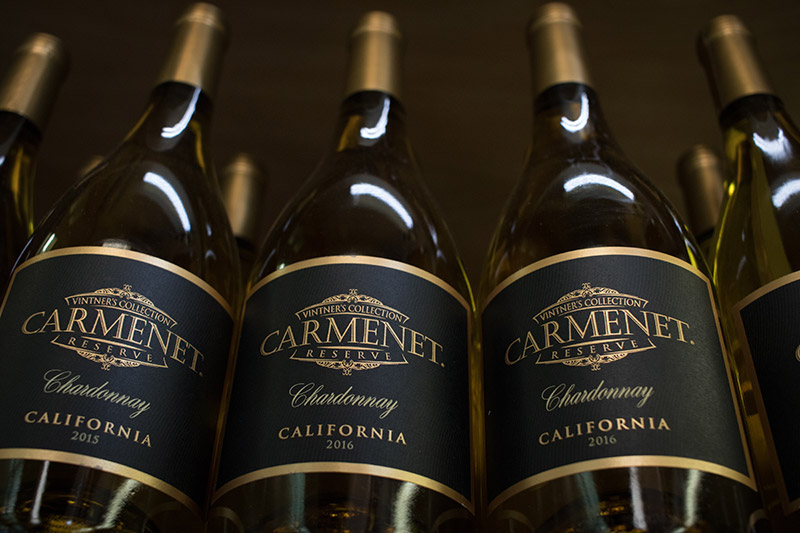Wooded. Unwooded. Oaked. Unoaked. Unlike you might initially think, this isn’t a case of potato-potatoh. When it comes to Chardonnay, there are two different styles of wine. Picking between a wooded or unwooded option will have a significant impact on the aroma and taste profile of the wine in your glass. How so? Allow us to explain the wonderful world of wooded and unwooded chardonnay…
Oh hey, Chardonnay
Chardonnay is the most popular white wine in the world. Known as the queen of the grapes, this green-skinned grape originated in the Burgundy region of France, but now grows in almost all major wine regions across the world, from Chile to New Zealand, Australia and South Africa. It’s a particularly popular grape as it is easy to grow and naturally neutral, making it wonderfully versatile in the cellar. This is where our interest is piqued, as depending on where the grapes are grown and how the wine is matured, the variety can quickly take on different characteristics.
What is Oaking?
In order to understand the difference between oaked and unoaked, let’s begin with what it means. Put simply, when a wine spends time in a barrel, it is exposed to two things – wood and air. By exposing wine to oak, the wine takes on the aroma of the oak (think wood shaving characters). It also adds tannins and helps to ‘thicken’ the wine, due to the fact that part of the wine in the barrel evaporates as, although the barrel is watertight, it’s not airtight. Finally, oak helps soften a wine. As the air seeps out, it also seeps in and oxygen transforms the wine. With time, wine becomes softer and the tannins become less harsh and more elegant.
Unwooded / Unoaked Chardonnay
In making an unwooded or unoaked Chardonnay, all this means is that the wine does not spend time in oak barrels. Typically, an unwooded Chardonnay will have the following characteristics:
- A light body
- A bouquet centered on fruit and citrus, notably apple, lime, and peach
- A brighter colour
- A crisp taste
If you prefer your wines to be lean, minerally and dry, then your perfect Chardonnay is the unwooded kind. It’s more similar to a wine profile of a Sauvignon Blanc or even Pinot Gris or Chenin Blanc.
Most unoaked Chardonnay is from cooler climate wine regions such as Sonoma Coast in California, the Loire and Chablis regions of France, Oregon and even Western Australia.
Wooded / Oaked Chardonnay
If you like the idea of creamy, rich white wine in your glass, you’ll love the classic style of wooded/oaked Chardonnay wine.
A wooded chardonnay has:
- A full body
- A rich texture
- A sweet bouquet, characterized by notes of vanilla and butterscotch
- A creamy, buttery taste, characterized by hazelnut, honey, and caramel
The impact of the wood leaves behind a delicious vanilla, oaky aroma and flavour. Furthermore, an oaked wine will often quickly be identified in a blind tasting because it develops a special texture that is often described as buttery, creamy or even smooth or waxy. This is because the wine undergoes a special kind of winemaking process in the barrel referred to as malolactic fermentation.
In basic terms, after the wine is fermented, an additional fermentation called Malolactic Fermentation (MLF) will give wine a ‘creamy’ texture. This is because MLF turns tart malic acid (the acid in apples) to smooth lactic acid (the acid in milk). What’s important to note is that not all unoaked chardonnays go through MLF whereas most oaked chardonnays do, so it’s hard to tell the difference between the oily texture of malo versus the buttery-vanilla flavour of oak. Don’t be stumped if you can’t identify the difference – even the best in the world can’t!
Many oaked Chardonnays come from warmer climate wine regions, such as Southern and Eastern Australia, Hemel-en-Aarde in South Africa, Napa Valley and of course the most famous Chardonnay region of all – Burgundy, France (especially areas like Puligny-Montrachet, Meursault and Mâconnais).
So how do you recognise when a wine has been oaked?
If a wine has spent time in barrels, you will find that the oak slowly imparts its flavours and colours into the wine. If this is a white wine, the longer the wine sits in oak, the darker a yellow it will become. When it comes to flavours, due to time spent in oak, the compound known as vanillin, which as the name suggests, tastes like vanilla. This flavour may be prominent on the nose and mouth. Other flavours that can be enhanced by oak are mocha, caramel, toffee or honey.
So the next time someone challenges you in a general knowledge test of wooded and unwooded Chardonnay, you’ll no doubt come out sounding like a pro! And remember, curating trips and tours around the beautiful South African and Portuguese Winelands is our forte. Should you be interested in exploring the world of unoaked and oaked Chardonnays, touch base with us and we will be happy to design an experience that covers the top Chardonnay wine estates.
